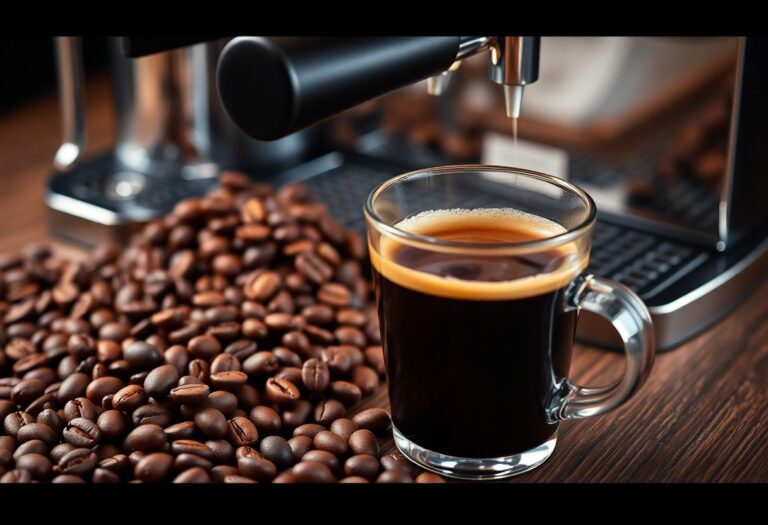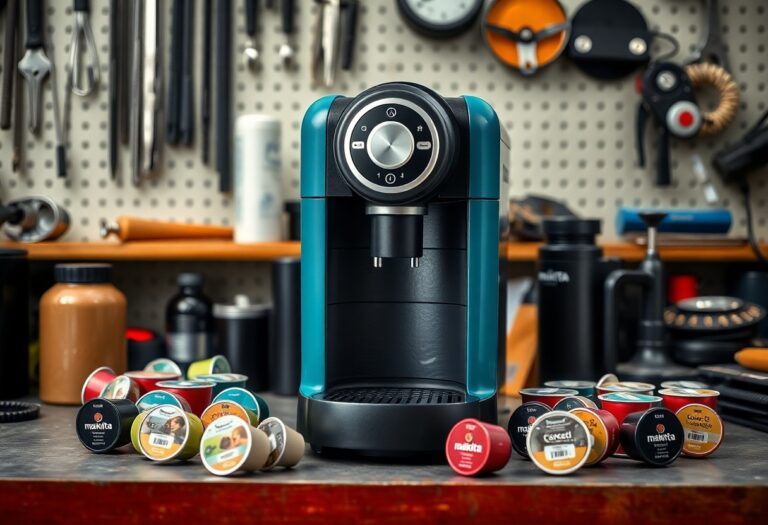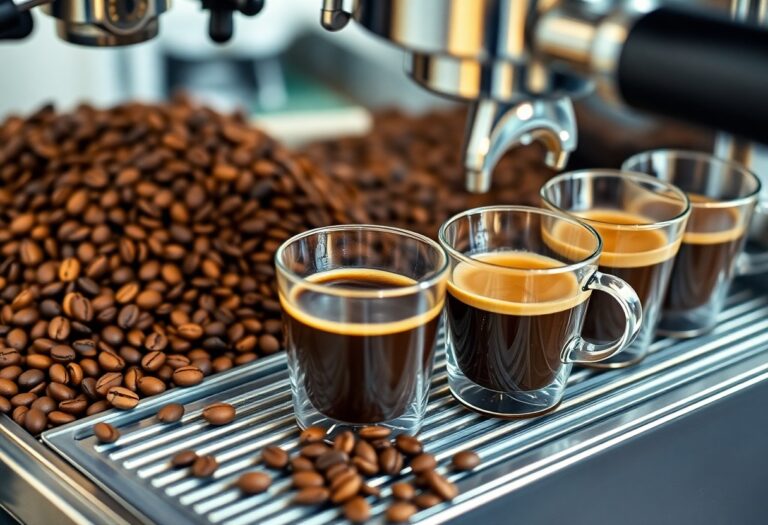What is an Espresso Coffee Machine – High-Pressure Brewing
Espresso is more than just a coffee; it’s a method that relies on high-pressure brewing to extract rich flavors and aromas from finely ground coffee beans. When you invest in an espresso coffee machine, you gain the ability to create bold, intense shots of espresso quickly and efficiently in the comfort of your home. Understanding how these machines work will help you appreciate the artistry behind your favorite café-style beverages while also giving you insight into the potential pitfalls of mishandling the brewing process.
Key Takeaways:
- Espresso coffee machines operate by forcing hot water through finely-ground coffee under high pressure, typically around 9 bars or more.
- The high-pressure brewing process is important for extracting rich flavors and creating a dense crema on top of the espresso.
- These machines come in various types, including manual, semi-automatic, fully automatic, and super-automatic, catering to different skill levels and preferences.
- Maintenance is important for these machines, involving regular cleaning and descaling to ensure optimal performance and longevity.
- Espresso can serve as a base for various coffee drinks, including lattes, cappuccinos, and Americanos, making it versatile for coffee enthusiasts.

The Mechanics of High-Pressure Brewing
Understanding the mechanics behind high-pressure brewing can elevate your espresso-making skills. This process relies on a pump that generates pressure, typically between 9 to 15 bars, forcing hot water through finely ground coffee. The result is a concentrated shot of espresso, complete with rich flavors and a velvety crema on top. By mastering this technique, you unlock a world of taste possibilities that define the espresso experience.
The Role of Pressure in Coffee Extraction
Pressure plays a vital role in coffee extraction, impacting flavor and aroma. When water is forced through coffee grounds at high pressure, it enhances the release of oils and soluble compounds, resulting in a rich and complex profile. Maintaining the right pressure ensures that your espresso is neither under-extracted, which leads to sour flavors, nor over-extracted, which can make it bitter.
The Anatomy of an Espresso Machine
The anatomy of an espresso machine consists of several key components working in unison. At its heart lies the boiler, which heats water to the perfect temperature, paired with a pump that generates the necessary pressure. The portafilter holds the coffee grounds, while the group head is where hot water is distributed evenly. Each component contributes to your overall brewing success, ensuring that every shot of espresso is crafted to perfection.
Examining the anatomy further, you will notice additional elements like the steam wand, used for frothing milk, and pressure gauges that help you monitor extraction levels. Some machines also feature built-in grinders for precision, ensuring that coffee is ground just before brewing to retain freshness. Even the design of the machine’s internal piping can affect temperature stability and pressure consistency, highlighting the intricate engineering involved in creating the perfect espresso experience.
The Nuanced Flavor Profiles of Espresso
Espresso is renowned for its complex and layered flavor profiles, reflecting its craft and precision. Each shot carries distinct notes ranging from fruity and floral to chocolatey and nutty, which can vary significantly based on the origin of the beans, roast level, and preparation. The quality of the extraction process, facilitated by high pressure and proper technique, plays a pivotal role in achieving the ideal balance of flavors, making it a sensory delight for enthusiasts.
Factors Influencing Taste: Grind Size and Coffee Beans
The flavor of your espresso is significantly influenced by the grind size and the coffee beans used. A fine grind increases surface area, which enhances extraction but can also lead to bitterness if over-extracted. The choice of coffee beans, including their origin and processing methods, contributes unique flavor notes to the final cup.
- Grind Size: Affects extraction and overall taste.
- Coffee Beans: Origin, roast, and processing define flavor profiles.
- Alterations in these factors will shift your espresso’s overall taste. The art of espresso lies in finding the perfect balance.
How Brewing Temperature Affects Espresso Quality
Brewing temperature serves as a critical variable in determining the quality of your espresso. The ideal temperature range is typically between 90-96°C (194-205°F), where optimal flavor extraction occurs without over-extracting undesirable bitter compounds. Deviating from this range can significantly alter the espresso’s taste profile.
Brewing Temperature Effects
| Temperature Range | Effect on Flavor |
|---|---|
| Below 90°C | Under-extraction leads to sour and weak flavors. |
| 90-96°C | Balanced extraction yields rich and complex flavors. |
| Above 96°C | Over-extraction can produce excessive bitterness. |
Fine-tuning the brewing temperature can elevate your espresso experience significantly. Consistency is key; minor adjustments might lead to massive differences in outcome. Experimenting within the optimal range allows you to discover distinct flavor nuances, highlighting the intrinsic qualities of your chosen beans. Keeping a thermometer handy during your brewing sessions may lead to remarkable results in flavor that complements your personal preference.
Temperature Impact on Espresso
| Understanding Temperature Impact | Flavor Profile Adjustment |
|---|---|
| 91°C | Bright acidity and fruity notes prevail. |
| 93°C | Harmonized balance with sweetness emerging. |
| 95°C | Rich body with a depth of flavor complexity. |
Common Misconceptions About Espresso Machines
Many enthusiasts fall victim to common misconceptions surrounding espresso machines, often underestimating their complexity or over-simplifying the brewing process. For example, some believe that all espresso machines are the same or that any coffee maker can achieve similar results. In reality, the high-pressure brewing techniques, along with the specific equipment requirements, play a significant role in flavor extraction. To investigate deeper into these nuances, take a look at Appliance Science: The high-pressure physics of espresso ….
Debunking Myths Surrounding Pressure and Flavor
One myth often circulated is that higher pressure always yields better flavor. However, while pressure does influence extraction, the balance of factors such as grind size, water temperature, and extraction time plays a pivotal role. Achieving a perfectly balanced shot is more about the harmony of these elements rather than simply cranking up the pressure.
Understanding the Equipment: Beyond the Basics
Your journey into espresso brewing requires more than just a machine; understanding the hardware involved is important for exceptional results. Espresso machines encompass various components, including the boiler, pump, and portafilter. Each interacts uniquely to ensure optimal flavor extraction. For instance, dual boilers allow for simultaneous brewing and steaming, enhancing versatility and control. Knowledge of these features and how they impact the brewing process equips you to create your perfect espresso with precision.
Diving deeper into the equipment, consider the differences between manual and automatic machines. Manual machines give you complete control over pressure and extraction time, perfect for fine-tuning your brew. On the other hand, automatic machines streamline the process, allowing consistent results for those who prefer convenience. Additionally, make space for a quality grinder; an even grind is important for optimal extraction. The investment in high-quality equipment not only improves your espresso but also enhances your overall coffee experience. Understanding these intricacies transforms your espresso routine into a sophisticated craft, ensuring every cup delights the senses.
Maintaining Your Espresso Machine for Optimal Performance
Regular maintenance enhances the longevity and functionality of your espresso machine. Routine tasks such as descaling, cleaning filters, and lubricating moving parts help prevent buildup of oils and minerals that can affect the quality of your brews. Furthermore, adhering to the manufacturer’s guidelines will ensure consistent performance, ultimately allowing you to craft the perfect espresso shot every time.
Essential Cleaning Techniques for Longevity
To keep your espresso machine in top shape, implement a daily cleaning routine that includes backflushing the group head and rinsing the portafilter. Weekly, deep clean the brewing components and water tank by using specialized cleaning tablets that dissolve coffee residue and oils. Monthly descaling with appropriate solutions will prevent mineral buildup, ensuring optimal water flow through the machine.
Troubleshooting Common Issues and Solutions
If your espresso machine exhibits issues like inconsistent pressure or poor extraction, addressing these problems promptly is key. Checking the grind size or adjusting the tamp can often solve extraction issues. If you experience slow water flow, inspect the filters and clean any clogs that may have developed over time.
Understanding common issues can save you from frustration and additional costs. For instance, if your machine fails to reach the desired temperature, check whether the boiler is functioning properly or if the heating element requires a replacement. In cases of leakage, inspecting the water lines and seals is vital. Documenting these troubleshooting steps can contribute to a more reliable experience, allowing you to enjoy coffee shop-standard espressos at home.
The Future of Espresso Technology
Focusing on espresso technology’s trajectory unveils a world of sophistication and innovation. Advancements aim to redefine quality, user experience, and sustainability. As coffee aficionados ponder how many bars of pressure for the perfect coffee and more, embrace a future where artificial intelligence might soon craft your ideal brew on command.
Innovations in Espresso Machine Design
Modern espresso machines are evolving at a rapid pace with designs that prioritize efficiency and user-friendliness. Innovations now include automatic milk frothers, integrated grinders, and touchscreen interfaces that provide real-time feedback on brewing parameters. These designs cater to both amateur baristas and seasoned veterans, ensuring that anyone can effortlessly achieve café-quality espresso at home.
The Growing Trend of Smart Espresso Appliances
Smart espresso appliances are gaining traction, allowing you to control brewing parameters from your smartphone. These devices often feature app connectivity, permitting you to customize your brew remotely or set schedules for when your coffee should be ready. With the integration of machine learning, these appliances can learn your preferences, adjusting automatically to create your perfect cup every time.
This trend reflects a broader move towards connectivity in kitchen appliances. For example, smart espresso machines may utilize cloud-based data to access seasonal coffee profiles or suggest recipes based on your taste history. Such features enhance convenience while ensuring that you have access to an exceptional coffee experience, tailored to your evolving preferences. The future of your morning ritual looks promising with these advancements in technology, combining heritage with innovation.
Final Words
Ultimately, understanding what an espresso coffee machine does and how high-pressure brewing works can elevate your coffee experience. By harnessing the power of pressure, you can extract rich flavors and aromas from your coffee beans, resulting in a delicious shot of espresso. As you explore different models and features, consider how they align with your preferences and brewing habits. Your journey into the world of espresso can lead to a rewarding and satisfying experience, enhancing both your knowledge and enjoyment of coffee.
FAQ
Q: What is an espresso coffee machine?
A: An espresso coffee machine is a specialized device designed to brew espresso coffee by forcing hot water through finely-ground coffee under high pressure. This process extracts rich flavors and creates a concentrated coffee shot with a layer of crema on top, which is the golden froth that forms during brewing.
Q: How does high-pressure brewing work?
A: High-pressure brewing involves using a pump to generate pressure, typically between 8 to 15 bars, to push hot water through the coffee grounds. This pressure helps extract oils, flavors, and aromas effectively from the coffee, resulting in a strong, full-bodied espresso. The process also enhances the crema, which contributes to the overall flavor and texture of the coffee.
Q: What are the main components of an espresso machine?
A: An espresso machine typically consists of several key components, including a water reservoir, a heating element, a pump, a brew group, a portafilter, and a steam wand. The water reservoir holds the water, the heating element heats it up, the pump generates the necessary pressure, the brew group holds the coffee grounds, and the portafilter connects the brew group to the espresso machine. The steam wand allows for frothing milk, enabling the creation of milk-based coffee drinks like lattes and cappuccinos.
Q: What factors affect the quality of espresso produced by a machine?
A: The quality of espresso can be influenced by several factors, including the grind size of the coffee, the water temperature, the brewing pressure, and the extraction time. A finer grind size typically results in a richer flavor, while water temperature between 90°C to 96°C (194°F to 205°F) is optimal for extraction. Additionally, the amount of pressure applied and the duration of brewing will determine the concentration and quality of the final espresso shot.
Q: Can I make other coffee beverages with an espresso machine?
A: Yes, an espresso machine is versatile and can be used to create a variety of coffee beverages beyond just espresso shots. With the addition of steamed or frothed milk, you can make lattes, cappuccinos, macchiatos, and flat whites. Some machines also come equipped with features that allow for brewing regular drip coffee or specialty drinks, making them suitable for various coffee preferences.







